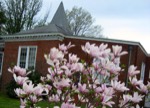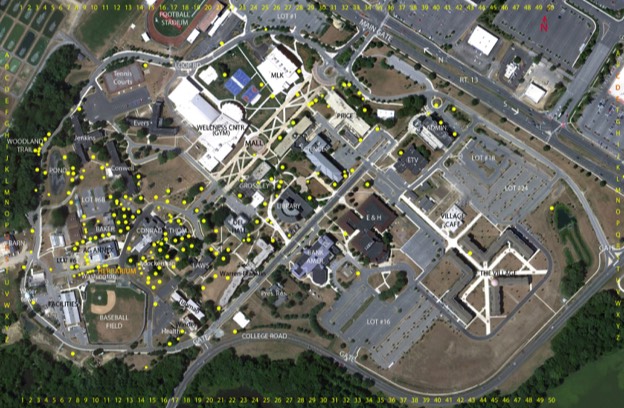DELAWARE STATE UNIVERSITY
Arboretum
TREES AND SHRUBS OF THE BEAUTIFUL DSU CAMPUS
Susan Yost Ph.D. and Lou Calabrese
Claude E. Phillips Herbarium, Dept. of Agriculture & Natural Resources, College of Agriculture & Related Sciences
Franklinia
Red maple, Loockerman Hall
Pawpaw
Mountain laurel
Black walnut, Delaware Hall

4"x6" tree label
Japanese flowering cherry
Two-wing silverbell
Sugar maple, Jason Library
Saucer magnolia, Thomasson Building

Governor Markell, with DSU President Williams, recognizing DSU as a Tree Campus USA, 2011.
INTERACTIVE MAP
Each yellow dot represents one of the 178 labeled tree and shrub species.
TO VIEW WEBPAGES FOR EACH SPECIES:
click on the MAP and then click on a YELLOW DOT,
or
click on the USE COMMON NAMES or USE SCIENTIFIC NAMES links to the left.
The DSU Arboretum is an Accredited Arboretum in the Morton Register of Arboreta, the first in Delaware and at an HBCU (2013).
DSU is also a Tree Campus USA, the first in Delaware (2011).
- The DSU Arboretum is composed of 178 different species of trees and shrubs planted on the main campus in Dover, each species labeled (118 labeled tree species, larger yellow dots on map; and 60 labeled shrub species, smaller yellow dots).
- These include 70 native species (native to Delaware), 100 *non-native species (not native to Delaware), and 8 **adventive species (not native to Delaware, but native to N. America and now growing wild in DE).
- Each tree label has common name, scientific name, family, native range, and a QR code to each species' webpage. There is also an outdoor Arboretum sign (36”x30”) (see Southern magnolia [Magnolia grandiflora]).
- All of the Arboretum trees and shrubs have educational and aesthetic value, and the native species in particular have ecological value.
- The diversity of the campus trees and shrubs was augmented by numerous trees planted in the 1960’s-70’s (Dr. N. Dill), 57 trees and shrubs (35 new species, 2/3 native) planted in 2010-2012 by the Herbarium (Dr. S. Yost), and trees provided by the Arbor Day Foundation (2012, 2013) and DDA (2012, 2015) for Arbor Day etc.
- The DSU Arboretum was formally established in 2012, and developed from the Campus Tree Walk (also Yost and Calabrese; in 2006) with the assistance of Claude E. Phillips Herbarium staff, volunteers and student workers; and was funded in part by USDA NIFA Capacity Building Program Grant #2008-38820-04790 (Yost, 2008-2012).
Notable trees:
All of the DSU Arboretum trees/shrubs have a story to tell; below are just a few notable ones:
- State Record tree (2nd largest of its species in Delaware): shingle oak (Quercus imbricaria)
- Other large/old trees: black walnut (Juglans nigra; on the waiting list for State Record tree); red maple (Acer rubrum), silver maple (Acer saccharinum), willow oak (Quercus phellos)
- Extinct in the wild: franklinia (Franklinia alatamaha)
- Historical in Delaware (not seen in the wild in >20 years): scrub oak (Quercus ilicifolia), black chokeberry (Aronia melanocarpa), redbud (Cercis canadensis).
- "Living fossils": dawn-redwood (Metasequoia glyptostroboides), ginkgo (Ginkgo biloba), umbrella-pine (Sciadopitys verticillata)
- Rare/unusual: monkey puzzle (Araucaria araucana), single-leaf pinyon pine (Pinus monophylla), American chestnut (Castanea dentata), Serbian spruce (Picea omorika)
- Edible fruits: pawpaw (Asimina triloba), Japanese persimmon (Diospyros kaki), American persimmon (Diospyros virginiana), beach plum (Prunus maritima), red chokeberry (Aronia arbutifolia), black chokeberry (A. melanocarpa), white mulberry (Morus alba), pear (Pyrus communis), American hazelnut (Corylus americana), chinquapin (Castanea pumila), American chestnut (Castanea dentata), etc.
- Ecological value for native wildlife: pawpaw (Asimina triloba) leaves are sole food for zebra swallowtail butterfly caterpillars; American sycamore (Platanus occidentals) major host of native sycamore lace bug; black cherry (Prunus serotina) fruits are major food for birds, leaves are important food for butterfly and moth caterpillars; white oak (Quercus alba), shagbark hickory (Carya ovata) and black walnut (Juglans nigra) nuts, and American persimmon (Diospyros virginiana) fruits are food for wildlife; inkberry (Ilex glabra), American holly (Ilex opaca), winterberry (Ilex verticillata), serviceberry (Amelanchier sp.), red-osier dogwood (Cornus sericea), arrowwood (Viburnum dentatum), blackhaw (V. prunifolium), and mistletoe (Phoradendron serotinum) fruits are food for birds; and tulip-tree (Liriodendron tulipifera), American holly (Ilex opaca) and linden (Tilia americana) are very important bee flowers in Delaware; and more!
- Beauty: Spring: flowering dogwood (Cornus florida), Japanese flowering cherry (Prunus serrulata 'Kwanzan'), saucer magnolia (Magnolia x soulangeana), redbud (Cercis reniformis 'Oklahoma'; also C. canadensis); Summer: southern magnolia (Magnolia grandiflora); Autumn: sugar maple (Acer saccharum), red maple (A. rubrum), sweet-gum (Liquidambar styraciflua), witch-hazel (Hamamelis virginiana); Winter: holly (Ilex 'Nellie R. Stevens', and other hollies), blue atlas cedar (Cedrus atlantica), crabapple (Malus hybrid), and hawthorn (Crataegus phaenopyrum); and more!
- Medicinal: willow (Salix nigra), ginkgo (Ginkgo biloba), hawthorn (Crataegus phaenopyrum), witch-hazel (Hamamelis virginiana), slippery elm (Ulmus rubra), yew (Taxus sp.), tree-of-heaven (Ailanthus altissima), etc.
- Economic value: Wood: white oak (Quercus alba, and other oaks), black walnut (Juglans nigra), white ash (Fraxinus americana), bitternut hickory (Cary cordiformis), Loblolly pine (Pinus taeda), white pine (Pinus strobus), empress-tree (Paulownia tomentosa), etc.
- Invasive in Delaware: tree-of-heaven (Ailanthus altissima), Norway maple (Acer platanoides), honey-locust (Gleditsia triacanthos), Bradford pear (Pyrus calleryana 'Bradford'), Redspire pear (P. calleryana 'Redspire'), sawtooth oak (Quercus acutissima), Japanese black pine (Pinus thunbergii), Japanese barberry (Berberis thunbergii), burning bush (Euonymus alata), and winter creeper (Euonymus fortunei).
- Tree Campus USA trees planted: umbrella-pine (Sciadopitys verticillata) 2011, American holly (Ilex opaca) 2012, redbud (C. canadensis ‘Heartbreaker’) 2013, weeping cherry (Prunus subhirtella 'Pendula Plena Rosea') 2014, river birch Dura-Heat™ (Betula nigra 'BNMTF') 2015 (pending).
Links:
- DSU Arboretum Slideshow (requires flash player)
- DSU Arboretum map/brochure
- DSU Arboretum herbarium specimen scans
- Claude E. Phillips Herbarium website
- DSU College of Agriculture and Related Sciences website (CARS)
Acknowledgements:
We are grateful for assistance from DSU faculty (especially Dr. A. Tucker, and Chairman Dr. R. Barczewski), volunteers (esp. L. Calabrese), student workers (esp. A. Downes, S. Taylor), and staff of the DSU Claude E. Phillips Herbarium, Dept. of Agriculture & Natural Resources; Cooperative Extension; and Facilities Management.
References:
- Coombes, Allen J. 1985. Dictionary of Plant Names. Timber Press, OR.
- Delaware Department of Agriculture. 2012. Big Trees of Delaware, 4th edition. Delaware Forest Service.
- Elias, Thomas. 1980. Trees of North America. Van Nostrand Reinhold Company, NY.
- Gleason, Henry and Arthur Cronquist. 1991. Manual of Vascular Plants of Northeastern United States and Adjacent Canada, 2nd edition. New York Botanical Garden, NY.
- Harlow, William. 1957. Trees of the Eastern and Central United States and Canada. Dover Publications, NY.
- McAvoy, William A. 2013. Flora of Delaware Online Database http://www.wra.udel.edu/de-flora/?l=3
- Petrides, George and Janet Wehr. 1998. Eastern Trees. Peterson Field Guide Series. Houghton Mifflin Company, NY.
- Taber, William. 2013. Delaware Trees, 4th edition. Delaware Forest Service.
Webpage Description:
Each of the 178 species webpages has: scientific and common names, family, native range, campus location (GPS, map coordinates, descriptive location), planting history, species descriptions including etymology and state rank (native, non-native, rare, invasive etc.), photographs, herbarium specimen image, and a locator map. Each tree label includes a QR code to each species' webpage.
Contact: herbarium@desu.edu
Last updated Dec 2015










